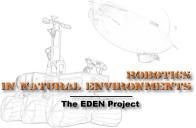Reach that goal
Autonomous rover navigation is the original and main objective of the
project, to which most of the work has been devoted up to now.  It
consists in endowing the rover with the capacity to autonomously execute
the task "Goto Goal", the goal being up to several kilometers far away
in an initally poorly known environment. For that purpose, the rover
must have the ability to perceive and model the environment, to localize
itself, and to generate and execute motions. All these processes must be
integrated and actively controlled within a decisional
real time architecture [Chatila 1995]: autonomous
navigation is a canonical instance of machine intelligence, on the basis
of which higher level tasks, such as exploration, reconoissance or
surveillance can be easily achieved. It
consists in endowing the rover with the capacity to autonomously execute
the task "Goto Goal", the goal being up to several kilometers far away
in an initally poorly known environment. For that purpose, the rover
must have the ability to perceive and model the environment, to localize
itself, and to generate and execute motions. All these processes must be
integrated and actively controlled within a decisional
real time architecture [Chatila 1995]: autonomous
navigation is a canonical instance of machine intelligence, on the basis
of which higher level tasks, such as exploration, reconoissance or
surveillance can be easily achieved.
General approach : adaptive navigation
The following images show three kind of terrains in our experimental
site, and the corresponding digital elevation maps. Would you drive your
rover the same way in each of these cases ?
For efficiency purposes, it is highly desirable that the rover
adapts its activities to the kind of terrain traversed. Indeed,
crossing a wide open area can be achieved on the basis of a simple
reactive "avoid obstacles" loop, whereas traversing a rough and dangerous
area requires slowest speeds, finer terrain modeling and finer motion
execution control for instance. The rover must therefore be able to choose
among a set of various navigation modes [Lacroix 1994, Chatila 1997]. The definition and the
number of these modes depend on the rover mechanical structure and on the
kind of terrains he might encounter during its missions.
A bunch of algorithms
A consequence of this adaptive approach is that each of the main
functionalities required by navigation i.e.
environment perception,
environment modeling,
localization,
motion generation and
motion execution,
can be achieved in various ways, depending on the
current active motion mode. A simple obstacle/free binary model of
the environment is sufficient to navigation in flat, open areas,
whereas a fine digital elevation map is required to cross a rough
area for instance. Similarly, motions can be either generated by
simple reactive methods, or planned on the basis of the mechanical
capacities of the rover chassis in rough areas. As for
localization, it is a so important functionality that it requires
the integration of various algorithms, from inertial navigation to
place recognition. All these algorithms are integrated within a modular,
evolutive architecture, and controlled according the context and
some pre-defined
navigation strategies [Lacroix 2002].
Every one ! See the people page.
|
[Chatila 1995]
| [related pages] [abstract] [BibTeX] [top] |
|
R. Chatila, S. Lacroix, T. Siméon and M. Herrb. Planetary Exploration by a Mobile Robot: Mission
Teleprogramming and Autonomous Navigation. In Autonomous Robots journal, 2(4), pages 333-344, 1995.
|
|
[Lacroix 2002]
| [related pages] [abstract] [download] [BibTeX] [top] |
|
S. Lacroix, A. Mallet, D. Bonnafous, G. Bauzil, S. Fleury, M. Herrb and R. Chatila. Autonomous Rover Navigation on Unknown Terrains: Functions
and Integration. In International Journal of Robotics Research, 21(10-11), pages 917-942, 2002.
|
| |
General Information
Robots
Rovers Navigation
Autonomous Blimps
Multi-Robot Cooperation
|

 It
consists in endowing the rover with the capacity to autonomously execute
the task "Goto Goal", the goal being up to several kilometers far away
in an initally poorly known environment. For that purpose, the rover
must have the ability to perceive and model the environment, to localize
itself, and to generate and execute motions. All these processes must be
integrated and actively controlled within a decisional
real time architecture [Chatila 1995]: autonomous
navigation is a canonical instance of machine intelligence, on the basis
of which higher level tasks, such as exploration, reconoissance or
surveillance can be easily achieved.
It
consists in endowing the rover with the capacity to autonomously execute
the task "Goto Goal", the goal being up to several kilometers far away
in an initally poorly known environment. For that purpose, the rover
must have the ability to perceive and model the environment, to localize
itself, and to generate and execute motions. All these processes must be
integrated and actively controlled within a decisional
real time architecture [Chatila 1995]: autonomous
navigation is a canonical instance of machine intelligence, on the basis
of which higher level tasks, such as exploration, reconoissance or
surveillance can be easily achieved.







